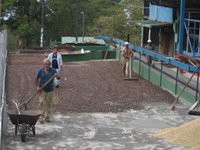Processing
| Much processing and human labour is required before coffee berries and its seed can be processed into roasted coffee with which most Western consumers are familiar. Picking Coffee berries are most commonly picked by hand by labourers who receive payment by the basketful. As of 2003, payment per basket is between US$2.00 to $10 with the overwhelming majority of the labourers receiving payment at the lower end. An experienced coffee picker can collect up to 6-7 baskets a day. Depending on the grower, coffee pickers are sometimes specifically instructed to not pick green coffee berries since the seeds in the berries are not fully formed or mature. This discernment typically only occurs with growers who harvest for higher end/specialty coffee where the pickers are paid better for their labour. Mixes of green and red berries, or just green berries, are used to produce cheaper mass consumer coffee beans, which are characterized by a displeasingly bitter/astringent flavour and a sharp greenish odour. Red berries, with its higher aromatic oil and lower organic acid content are more fragrant, smooth, and mellow. As such coffee picking is one of the most important stages in coffee production, and is the chief determinant for the quality of the end product. Defruiting The coffee berries are a type of drupe, with fruit flesh directly covering the coffee bean. For "washed" coffees, after harvesting, the flesh of the coffee berry must be quickly removed by soaking, scouring and/or mechanical rubbing. The defruited coffee bean is flushed with water to remove clinging fruit and additional sugars before drying. These coffees tend to rest in water (the "ferment" stage) for a set amount of time (depending on the origin and producer). Washed coffees tend to be described as "clean" and "bright." Coffees called "naturals" are those where the fruit is not immediately removed from the beans, but is instead allowed to dry and partially ferment. This creates a unique flavour profile with reduced acidity and increased body, though if done poorly can lead to lower quality beans. Other coffee processing methods include the Pulped Natural process, the Indonesian "semi-washed" methods as well as aguapulping and re-fermentation. Each produces its own flavour profile and each is, in essence, a different way of handling the process of defruiting the beans. Drying Coffee beans are spread over a large concrete or rock surface where they are dried by air and sunlight. The beans are repeatedly raked into rows and spread out over the course of several days until they are largely dry. At this stage, the beans are referred to as "green coffee".  |




Comments on "Processing"
-
 Bunyamin Najmi said ... (4:06 AM) :
Bunyamin Najmi said ... (4:06 AM) :
-
 154154 said ... (6:40 PM) :
154154 said ... (6:40 PM) :
post a commentblognya ok punya...
jadi minder saya.
Saya juga baru belajar jadi blogger, bos. Terus posting, bos.
Tks, ah saya juga masih belajar kok,, masih banyak yang belum bisa: SEO, rss, blognya word press,,, masih bnyak lagi yg belum bisa, kurang waktu,,, any way sy bikin blog ini karena saya penikmat kopi,, artikelnya juga saya mbil dari banyak free source, belum bisa nulis sendiri. Blog saya yang lain : www.wtcui.info check it out... : )
<< Home - coffee addict